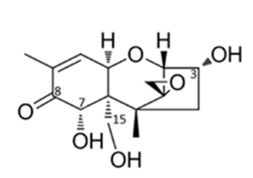Deoxynivalenol (DON), a trichothecene mycotoxin also called vomitoxin due to the characteristic emesis in acute toxicosis, is a secondary metabolite of Fusarium fungi and one of the most prevalent mycotoxins in grain-based food and feed products worldwide. In Europe, humans are generally exposed to DON through the diet chronically at low levels. In Norway, children are exposed to levels close or exceeding the tolerable daily intake (TDI) of 1 μg/kg bw/day. Domestic animals are also sensitive to DON and specific maximal limits for feed- and foodstuffs have been established by the European Union.

Critical effects of non-acute DON intoxication are impairment of the immune system, gastrointestinal and central inflammation, and anorexia (food refusal and loss of weight gain). Furthermore, orally exposed laboratory (mice, rats) and domestic animals (pig, chicken) show dose-dependent behavioural changes such as increased locomotive activity and aggression suggesting that DON might also directly affect the central nervous system (CNS). DON can pass through the blood-brain barrier and modulate brain neuronal activity by influencing the cytokine levels, biogenic monoamines metabolism and secretion of the satiety hormone cholecystokinin. Decreased neural cell viability and increased c-Fos in some brain structures have been shown. Mice have been established as an appropriate model for the study of brain-effective compounds.
 The DONNER project investigates neurotoxicological effects of chronic low-level exposure to DON. The project is a cooperation of the Norwegian Veterinary Institute (NVI), Oslo, Norway, and the Institute of Cellular and Integrative Neurosciences (INCI), Strasbourg, France, combining expertise in mycotoxinology and neurobiology. The effects of low DON concentrations are studied in vitro with murine astrocytes and glia cells, and in vivo in DON-exposed mice by performing different behavioural test.
The DONNER project investigates neurotoxicological effects of chronic low-level exposure to DON. The project is a cooperation of the Norwegian Veterinary Institute (NVI), Oslo, Norway, and the Institute of Cellular and Integrative Neurosciences (INCI), Strasbourg, France, combining expertise in mycotoxinology and neurobiology. The effects of low DON concentrations are studied in vitro with murine astrocytes and glia cells, and in vivo in DON-exposed mice by performing different behavioural test.
In a follow-up study, brain mycotoxicosis of DON is currently studied with epigenetics and imaging techniques in different brain regions of chronically exposed mice.
Publications
- Fæste, C.K., Solhaug, A., Gaborit, M., Pierre, F., and Massotte, D. Neurotoxic potential of deoxynivalenol in murine brain cell lines and primary hippocampal cultures. Toxins 2022, 14, 48.
- Fæste CK, Pierre F, Ivanova L, Sayyari A, Massotte D. Behavioural and metabolomic changes from chronic dietary exposure to low-level deoxynivalenol reveal impact on mouse well-being. Arch Toxicol 2019, 93, 2087–2102.
Presentations
- Fæste CK. Mycotoxins: Old foes – new finds. ITI NeuroStra “le système nerveux: de l’adaptation aux pathologies (https://neurostra.unistra.fr/en/)”, 21.10.2022, Institut des Neurosciences Cellulaires et Intégratives, Université de Strasbourg, France.
- Fæste CK. Muggsoppgiften DON i korn gir skye og asosiale mus. Forskningsdagene, 21.9.2020, Oslo, Norway.Fæste CK.
- Skye mus i DON-rus. Sluttseminar til FUNTox, a strategic institute program on Fungi and Mycotoxins in a “One Health” perspective. 11.1.2019, Oslo, Norway.
- Fæste CK. Mycotoxins – old foes, new finds. Biologically Active Compounds in Food. 3nd International Conference. 19.-20.9.2019. Lodz, Poland.
- Fæste CK. Ny innsikt om en gammel bekjent: toksikodynamikk og –kinetikk til mykotoksinet deoksynivalenol. 23.4.2019, NMBU, Oslo, Norway.
Funding: NFR Aurora/Campus France 2016-2018.